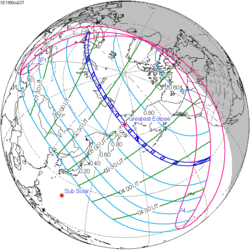| Partial eclipse | |
| Gamma | 1.1293 |
|---|---|
| Magnitude | 0.735 |
| Maximum eclipse | |
| Coordinates | 65°18′N56°54′E / 65.3°N 56.9°E |
| Times (UTC) | |
| Greatest eclipse | 9:32:09 |
| References | |
| Saros | 122 (56 of 70) |
| Catalog # (SE5000) | 9471 |
A partial solar eclipse occurred at the Moon's descending node of orbit on Wednesday, December 15, 1982, [1] with a magnitude of 0.735. A solar eclipse occurs when the Moon passes between Earth and the Sun, thereby totally or partly obscuring the image of the Sun for a viewer on Earth. A partial solar eclipse occurs in the polar regions of the Earth when the center of the Moon's shadow misses the Earth.
Contents
- Eclipse details
- Eclipse season
- Related eclipses
- Eclipses in 1982
- Metonic
- Tzolkinex
- Half-Saros
- Tritos
- Solar Saros 122
- Inex
- Triad
- Solar eclipses of 1982–1985
- Saros 122
- Metonic series
- Tritos series
- Inex series
- References
- External links
This was the last of four partial solar eclipses in 1982, with the others occurring on January 25, June 21, and July 20.
A partial eclipse was visible for parts of Northeast Africa, Europe, the Middle East, South Asia, and Central Asia.



































































































